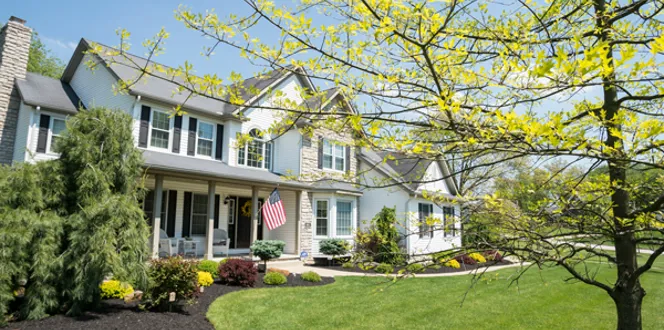Young trees have a way of making our minds wander. One minute you’re looking at a slender stalk with bare twigs, and the next you’re imagining the tall beauty it will soon be.
And that’s a good thing! You want to envision just how big your soon-to-be tree will get and what that means for your home before you plant.
When you choose the right tree, you save yourself the future headache of roots damaging your home’s foundation or fallen leaves constantly at your front door. Make the stress-free choice by learning about the best and worst trees to plant near a house below.
How close can you plant trees to a house, anyway?
This question all comes down to tree size. After all, the wide-root oak tree that’s 70 feet tall needs much more room than the modest Japanese maple.
A good rule of thumb is to start at about 8 to 10 feet away from your home for small trees and scale up to account for the tree’s mature height and spread.
Worst Trees to Plant Near a House
The trees on this short list are deemed the worst because of their widespread, invasive roots. These are just the top offenders, though!
Once you find a tree you like, do a little research to see how fast growing and destructive their roots could be.
 White ash (Zones 2-9): A fast-growing shade tree with invasive, lateral roots that’s also susceptible to emerald ash borer!
White ash (Zones 2-9): A fast-growing shade tree with invasive, lateral roots that’s also susceptible to emerald ash borer!- Poplar (Zones 3-8): A tall tree with aggressive roots known for causing sewer and foundational damage
- American elm (Zones 3-9): A full tree that has shallow roots that can disrupt your lawn, sidewalk or driveway
- Silver maple (Zones 3-9): A tree with gorgeous, shimmery leaves that also has roots that often end up growing above the ground
- Weeping willow (zones 6-8): A large shade tree that commonly invades sewer lines
- Oak (Zones 8-10): A fast-growing, beloved tree notorious for causing foundational damage
Best Trees to Plant Near a House
These trees make the list because of their non-invasive roots or low-maintenance cleanup. Plus, it helps that they’re all beautiful trees!
 Crabapple (Zones 3-8): A short, flowering tree that matures at about 20 feet tall. Be sure to pick a disease-resistant tree to avoid headaches later!
Crabapple (Zones 3-8): A short, flowering tree that matures at about 20 feet tall. Be sure to pick a disease-resistant tree to avoid headaches later!- American hornbeam (zones 3-9): A slow-growing member of the birch family that’s small in size
- Cornelian-cherry dogwood (Zones 4-7): An excellent small tree that puts on the best possible show of flowers when planted in front of a dark background
- Japanese maple (zones 5-8): A popular scarlet-colored tree that’s ideal for planting at a curbside location or near a patio
- Flowering dogwood (Zones 5-8): A delicate, flowering tree great for planting near walls
- American holly (zones 5-9): A popular evergreen tree that’s low-maintenance









